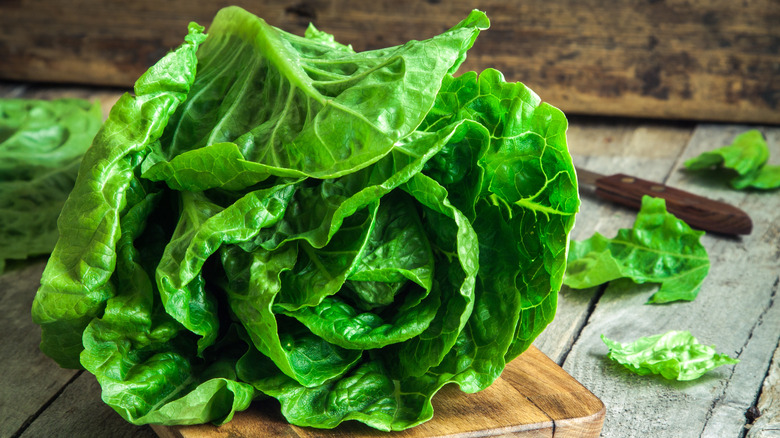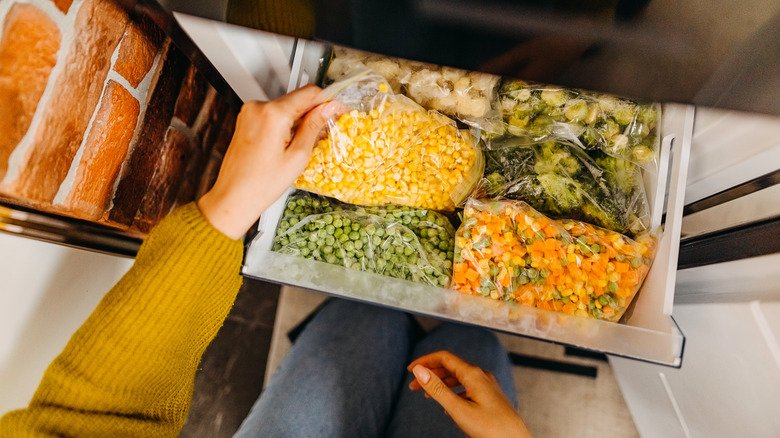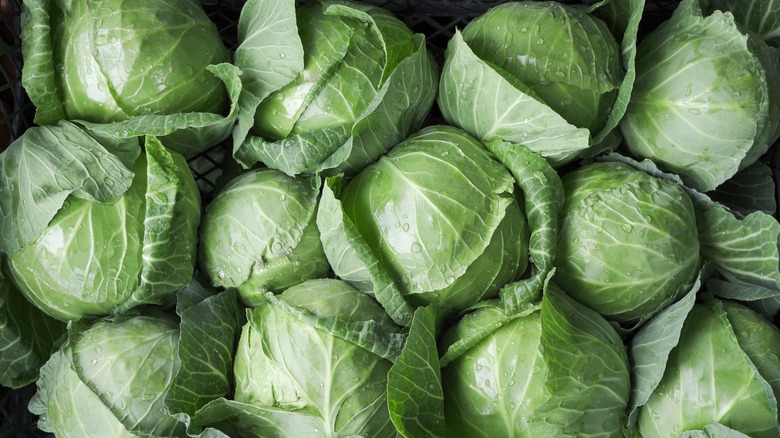Why You Shouldn't Freeze Lettuce And Cabbage
If you've found yourself with a bunch of extra lettuce or cabbage and you're hoping to save them by putting them in the freezer, think again. Freezing the raw versions of these vegetables typically ends badly: When lettuce is thawed, you can expect them to be waterlogged and limp, according to the National Center for Food Preservation. The leaves may also become oxidized, which means they turn a reddish-brown color, which happens when it's exposed to too much moisture.
The same generally applies to cabbage, although the situation is a bit more complex since it's possible to cook or marinate cabbage in a way that allows you to freeze it. But if you put a crisp raw cabbage directly in the freezer, it may come out soft and squishy with a generally unpleasant texture when you thaw it, and would not make for a good slaw or other dish that calls for crisp cabbage. But there's some ambiguity around this question: Frozen raw cabbage may lose all of its crispness and become soft in texture, but it could still be suitable for dishes where it'll be cooked, especially if it's dishes with lots of liquid like soups and stews. This way, the softness of the thawed cabbage doesn't really matter since the cooking process would soften it up either way.
What happens when you freeze lettuce
Lettuce is a particularly watery vegetable (it can be over 95% water), and this is a key reason why it freezes so poorly. All that water inside the lettuce freezes into ice crystals, and because frozen water expands, those crystals break down the cell walls and overall integrity of the lettuce. This breakdown is why it becomes mushy when you thaw it: All of the "skin" of the vegetable has been ruined. For this reason, you'll run into the same problem with other vegetables with a high water content, such as mushrooms and cucumbers.
It's theoretically possible to freeze lettuce if you plan to use it in watery recipes like smoothies or soups, but not salads. Pureeing lettuce before freezing is one recommendation if you plan to do this. It's probably a better idea for leafy greens like kale and spinach (which are not technically lettuce), which fit well into soups and smoothies. While the idea of an iceberg lettuce soup might sound strange, some recipes involve cooked lettuce out there, from stir-fries to broths, and these might work with frozen and thawed lettuce.
Frozen cabbage: Blanch it first
Freezing cabbage isn't always a no-no, if you approach it properly. Throwing a raw cabbage into the freezer will likely result in a very mushy thaw for the same reasons as lettuce, but not if you blanch the fresh cabbage before freezing it. The process, if you forgot or never knew is to put cabbage into a pot of boiling water for 1 to 2 minutes, before putting it into a bowl of ice water to stop the cooking process. The cabbage can be cut into wedges, strips, or peeled into leaves before blanching. When this is done, you should dry the cabbage as much as possible before putting it into an airtight container (the less air, the better).
Frozen cabbage can be used for a range of dishes: Cooked dishes like soups, sautés, and stews work well (and you can add the frozen cabbage directly without thawing it). If blanched properly, thawed frozen cabbage may be crisp enough for slaw, although it may be wiser to use fresh cabbage.
It's easy to freeze cooked cabbage (for example, if it's sautéed or part of a soup) without special treatment — cooking makes vegetables release water, reducing the issue of ice crystals forming when the cabbage is frozen. Fermented cabbage like sauerkraut can be frozen without much damage to the texture or flavor, although some fans are skeptical of this because it can diminish the fermentation effects and growth of probiotics.


